设计型作业题目
3.3 (要求学号末位为奇数的学生必作,学号末位为偶数的学生选作。可以参考《数据结构题集(C 语言版)》,第96页,实习2 栈和队列及其应用,第2.1题:停车场管理,难度系数为3。题目有些改变)某商场有一个100个车位的停车场,当车位未满时,等待的车辆可以进入并计时;当车位已满时,必须有车辆离开,等待的车辆才能进入;当车辆离开时计算停留的时间,并且按照每小时10元收费。
汽车的输入信息格式可以是(进入/离开,车牌号,进入/离开时间),要求可以随时显示停车场内的车辆信息以及收费历史记录。
3.4 (要求学号末位为偶数的学生必作,学号末位为奇数的学生选作。这个题目不是《数据结构题集(C 语言版)》,第100页,实习2 栈和队列及其应用,第2.6题:银行业务模拟,习题集上题目的难度系数为5。留作研究型题目吧!)某银行营业厅共有6个营业窗口,设有排队系统语音叫号。该银行的业务分为公积金、个人卡、企业卡等3种。公积金业务指定1号窗口,个人卡业务指定2、3、4号窗口,企业卡业务指定5、6号窗口。但如果5、6号窗口全忙,而2、3、4号窗口有空闲时,企业卡业务也可以在空闲的2、3、4号窗口之一办理。
客户领号、业务完成可以作为输入信息,要求可以随时显示6个营业窗口的状态。
3.5 (所有学生必作,《数据结构题集(C 语言版)》,第26页,第3.32题的简化版:原题难度系数为4。参考本章课堂幻灯片。)
原第3.32题(参考本章幻灯片):
试利用循环队列编写求k阶Fibonacci序列中前n+1项(f0, f1 , f2 ,… fn)的算法,要求满足fn≤max而fn+1>max,其中max为某个约定的常数。(注意本题所用循环队列的容量仅为k,则在算法执行结束时,留在循环队列中的元素应是k阶斐波那契序列中的最后k项fn-k+1, … fn)。
本题具体化为下列要求:
已知4阶Fibonacci斐波那契序列如下:f0=f1=f2=0, f3= 1, … , fi= fi-1+fi-2+fi-3+fi-4,利用容量为k=4的循环队列,构造序列的前n+1项(f0, f1 , f2 ,… fn),要求满足fn≤200而fn+1>200。
3.6 (选作题,八皇后问题,Eight Queens Problem):设8皇后问题的解为(x1, x2, x3, …,x8),约束条件为:在8x8的棋盘上,其中任意两个xi和xj不能位于棋盘的同行、同列及同对角线。要求用一位数组进行存储,输出所有可能的排列。
3.7 (所有学生必作。《数据结构题集(C 语言版)》,第105页,实习2 栈和队列及其应用,第2.9题:迷宫问题,Maze Problem,题目难度系数为4。请同学们务必阅读第105页至第115页,并严格按照习题集之上的要求撰写设计报告。)
迷宫求解:用二维矩阵表示迷宫,自动生成或者直接输入迷宫的格局,确定迷宫是否能走通,如果能走通,输出行走路线。
设计型作业题目解答
【第3.3题解答】
解题思路:
通过switch语句分别判断用户要执行的操作,车辆进入时,存入车牌号和停车时间,车辆离开时,输入车牌号和离开的时间,打印停车场信息,则将车辆信息逐个输出,为程序运行方便,将以下程序将停车场的位置设为3
实验结果截图:
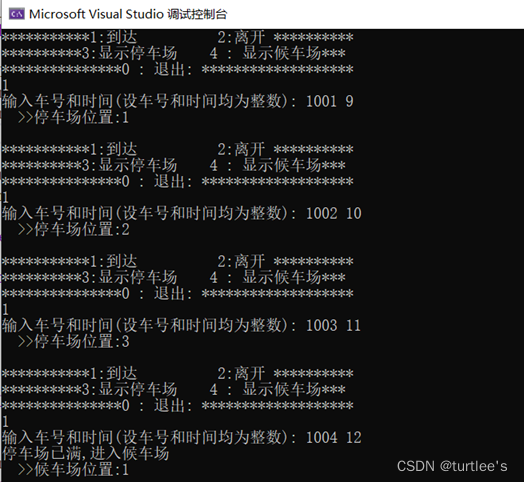
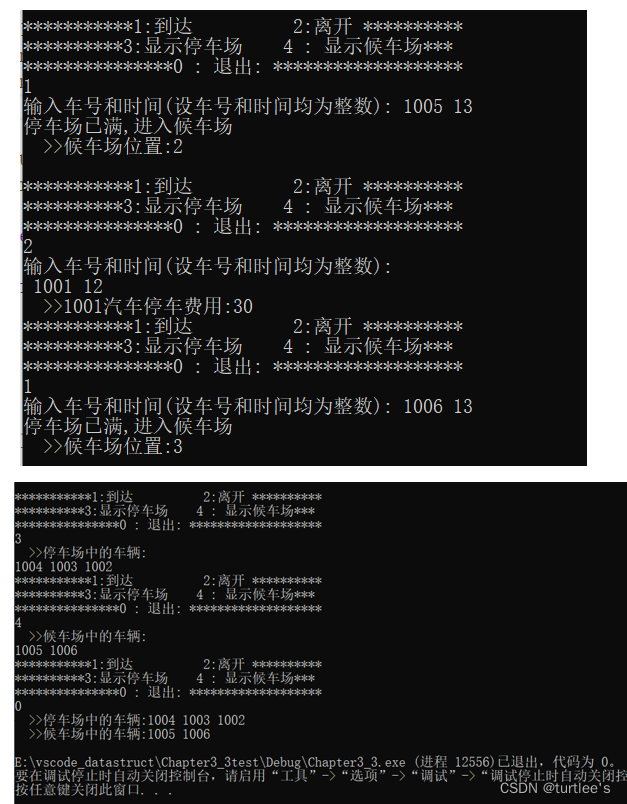
源代码:
main.cpp
#include "Chapter3_3.h"
int main() {
int comm;
int no, e1, time, e2;
int i, j;
SqStack* St, * St1;//St是停车场,St1是在有车离开时记录为该车移开位置的车辆
SqQueue* Qu; //Qu是候车场
InitStack(St);
InitStack(St1);
InitQueue(Qu);
do
{
printf("***********1:到达 2:离开 **********\n");
printf("**********3:显示停车场 4 : 显示候车场***\n");
printf("***************0 : 退出: *******************\n");
scanf_s("%d", &comm);
switch (comm)
{
case 1: /*汽车到达*/
printf("输入车号和时间(设车号和时间均为整数): ");
scanf_s("%d%d", &no, &time);
if (!StackFull(St)) /*停车场不满*/
{
Push(St, no, time);
printf(" >>停车场位置:%d\n", St->top + 1);
}
else /*停车场满*/
{
if (!QueueFull(Qu)) /*候车场不满*/
{
EnQueue(Qu, no);
printf("停车场已满");
printf("停车场已满,进入候车场\n");
printf(" >>候车场位置:%d\n", Qu->rear);
}
else
printf(" >>候车场已满,不能停车\n");
}
break;
case 2: /*汽车离开*/
printf("输入车号和时间(设车号和时间均为整数): ");
scanf_s("%d%d", &no, &time);
for (i = 0; i <= St->top && St->CarNo[i] != no; i++); //在栈中找
if (i > St->top)
printf(" >>未找到该编号的汽车\n");
else
{
for (j = i; j <= St->top; j++)
{
Pop(St, &e1, &e2);
Push(St1, e1, e2); /*倒车到临时栈St1中*/
}
Pop(St, &e1, &e2); /*该汽车离开*/
printf(" >>%d汽车停车费用:%d\n", no, (time - e2) * Price);
while (!StackEmpty(St1)) /*将临时栈St1重新回到St中*/
{
Pop(St1, &e1, &e2);
Push(St, e1, e2);
}
if (!QueueEmpty(Qu)) /*队不空时,将队头进栈St*/
{
DeQueue(Qu, &e1);
Push(St, e1, time); /*以当前时间开始计费*/
}
}
break;
case 3: /*显示停车场情况*/
if (!StackEmpty(St))
{
printf(" >>停车场中的车辆:"); /*输出停车场中的车辆*/
DisStack(St);
}
else
printf(" >>停车场中无车辆\n");
break;
case 4: /*显示候车场情况*/
if (!QueueEmpty(Qu))
{
printf(" >>候车场中的车辆:"); /*输出候车场中的车辆*/
DisQueue(Qu);
}
else
printf(" >>候车场中无车辆\n");
break;
case 0: /*结束*/
if (!StackEmpty(St))
{
printf(" >>停车场中的车辆:"); /*输出停车场中的车辆*/
DisStack(St);
}
if (!QueueEmpty(Qu))
{
printf(" >>候车场中的车辆:"); /*输出候车场中的车辆*/
DisQueue(Qu);
}
break;
default: /*其他情况*/
printf(" >>输入的命令错误\n");
break;
}
} while (comm != 0);
return 0;
}
Chapter 3_3.h
#include <stdio.h>
#include <malloc.h>
#define N 3//停车场内最多的停车数
#define M 4//候车场内最多的车辆数
#define Price 10//每小时收费10元
typedef struct {
int CarNo[N];//车牌号
int CarTime[N];//进场时间
int top;//栈顶指针
}SqStack;
typedef struct {
int CarNo[M];//车牌号
int front, rear;//头指针和尾指针
}SqQueue;//定义顺序队列的循环类型
//顺序栈的基本操作
void InitStack(SqStack* S);
int StackEmpty(SqStack* S);
int StackFull(SqStack* S);
int Push(SqStack* S, int e1, int e2);
int Pop(SqStack* S, int* e1, int* e2);
void DisStack(SqStack* S);
//循坏队列的基本操作
void InitQueue(SqQueue* Q);
int QueueEmpty(SqQueue* Q);
int QueueFull(SqQueue* Q);
int EnQueue(SqQueue* Q, int e);
int DeQueue(SqQueue* S, int* e);
void DisQueue(SqQueue* Q);
Chapter3_3.cpp
#include "Chapter3_3.h"
void InitStack(SqStack* S) {
S = (SqStack*)malloc(sizeof(SqStack));
S->top = -1;
}
int StackEmpty(SqStack* S) {
return (S->top = -1);
}
int StackFull(SqStack* S) {
return (S->top == N - 1);
}
int Push(SqStack* S, int e1, int e2) {
if (S->top == N - 1)
return 0;
S->top++;
S->CarNo[S->top] = e1;
S->CarTime[S->top] = e2;
return 1;
}
int Pop(SqStack* S, int* e1, int* e2) {
if (S->top == -1)
return 0;
*e1 = S->CarNo[S->top];
*e2 = S->CarTime[S->top];
S->top--;
return 1;
}
void DisStack(SqStack* S) {
int i;
for (i = S->top; i >= 0; i--) {
printf("车牌号为%d", S->CarNo[i]);
printf("\n");
}
}
void InitQueue(SqQueue* Q) {
Q = (SqQueue*)malloc(sizeof(SqQueue));
Q->front = Q->rear = 0;
}
int QueueEmpty(SqQueue* Q) {
return (Q->front = Q->rear);
}
int QueueFull(SqQueue* Q) {
return ((Q->rear + 1) % M == Q->front);
}
int EnQueue(SqQueue* Q, int e) {
if ((Q->rear + 1) % M == Q->front)
return 0;
Q->rear = (Q->rear + 1) % M;
Q->CarNo[Q->rear] = e;
return 1;
}
int DeQueue(SqQueue* Q, int* e) {
if (Q->front == Q->rear)
return 0;
Q->front = (Q->front + 1) % M;
*e = Q->CarNo[Q->front];
return 1;
}
void DisQueue(SqQueue* Q) {
int i;
i = (Q->front + 1) % M;
printf("%d", Q->CarNo[i]);
while ((Q->rear - i + M) % M > 0) {
i = (i + 1) % M;
printf("%d", Q->CarNo[i]);
}
printf("\n");
}
【第3.4题解答】
运行结果截图:
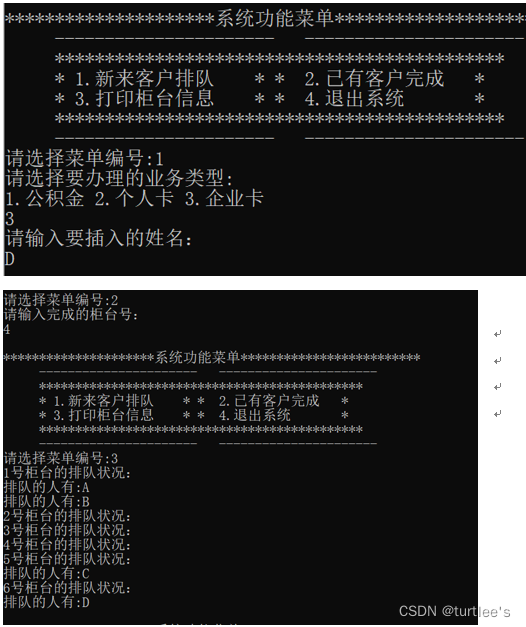
源代码:
main.cpp
#include "Chapter3_4.h"
int main() {
printf(" \n\n \n\n");
printf(" ***************************************************\n\n");
printf(" * 简易柜台模拟系统 *\n \n");
printf(" ***************************************************\n\n");
Quene S1, S2, S3, S4, S5, S6;
InitQueue(S1);
InitQueue(S2);
InitQueue(S3);
InitQueue(S4);
InitQueue(S5);
InitQueue(S6);
int num;
while (1) {
WelcomePrint();
scanf_s("%d", &num);
getchar();
switch (num) {
case 1: {
int k;
Choice();
scanf_s("%d", &k);
getchar();
char ch;
if (k == 1) {
printf("请输入要插入的姓名:\n");
scanf_s("%c", &ch, 1);
Encycque(&S1, ch);
}
else if (k == 2) {
printf("请输入要插入的姓名:\n");
scanf_s("%c", &ch, 1);
if (QueueEmpty(S2)) {
Encycque(&S2, ch);
}
else if (QueueEmpty(S3)) {
Encycque(&S3, ch);
}
else if (QueueEmpty(S4)) {
Encycque(&S4, ch);
}
else {
Encycque(&S2, ch);
}
}
else if (k == 3) {
printf("请输入要插入的姓名:\n");
scanf_s("%c", &ch, 1);
if (QueueEmpty(S5)) {
Encycque(&S5, ch);
}
else if (QueueEmpty(S6)) {
Encycque(&S6, ch);
}
else if (QueueEmpty(S4)) {
Encycque(&S4, ch);
}
}
break;
}
case 2:{
int j;
printf("请输入完成的柜台号:\n");
scanf_s("%d", &j);
switch (j) {
case 1:
Delcycque(&S1);
break;
case 2:
Delcycque(&S2);
break;
case 3:
Delcycque(&S3);
break;
case 4:
Delcycque(&S4);
break;
case 5:
Delcycque(&S5);
break;
case 6:
Delcycque(&S6);
break;
}
break;
}
case 3:
printf("1号柜台的排队状况:\n");
Traverseque(S1);
printf("2号柜台的排队状况:\n");
Traverseque(S2);
printf("3号柜台的排队状况:\n");
Traverseque(S3);
printf("4号柜台的排队状况:\n");
Traverseque(S4);
printf("5号柜台的排队状况:\n");
Traverseque(S5);
printf("6号柜台的排队状况:\n");
Traverseque(S6);
break;
case 4:
exit(-1);
}
}
return 0;
}
Chapter3_4.h
#pragma once
#pragma once
#include<stdio.h>
#include<string.h>
#include<stdlib.h>
#include<malloc.h>
#define TRUE 1
#define FALSE 0
#define OK 1
#define ERROR 0
#define INFEASIBLE -1
#define OVERFLOW -2
#define MAXQSIZE 5
typedef int ElemType;
typedef int Status;
typedef struct {
ElemType quene[MAXQSIZE];
int front, rear;
}Quene;
Status Initquene(Quene* Q);
Status Delcycque(Quene* Q);
Status Encycque(Quene* Q, ElemType x);
Status Traverseque(Quene Q);
Chapter3_4.c
#include "Chapter3_4.h"
Status Initquene(Quene* Q) {
Q->front = 0;
Q->rear = 0;
return OK;
}
Status Delcycque(Quene* Q, ElemType* e) {
if (Q->front == Q->rear) {
return(NULL);
}
else {
*e = Q->quene[Q->front];
Q->front = (Q->front + 1) % MAXQSIZE;
return OK;
}
}
Status Encycque(Quene* Q, ElemType x) {
if ((Q->rear + 1) % MAXQSIZE == Q->front) {
return ERROR;
}
else {
Q->quene[Q->rear] = x;
Q->rear = (Q->rear + 1) % MAXQSIZE;
return OK;
}
}
Status Traverseque(Quene Q) {
for (int i = 0; i < 4; i++) {
printf("第%d个元素是:%d\n", i + 1, Q.quene[i]);
}
return OK;
}
【第3.5题解答】
解题思路:
根据f0=f1=f2=0, f3= 1,建立递推公式: fi= fi-1+fi-2+fi-3+fi-4,利用队列的增加、删除等基本操作当有元素进入队列时,如果尾指针不指向最后一个元素,元素直接插入,否则,利用Q->rear = (Q->rear + 1) % MAXSIZE进行循环队列的操作。
实验结果截图:
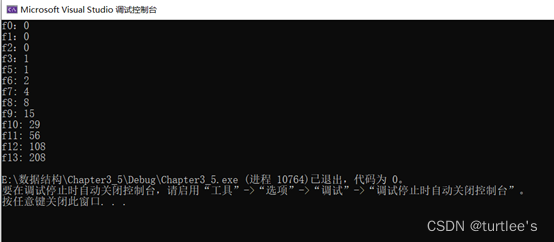
源代码:
main.cpp
#include "SqQuence.h"
int main()
{
SqQueue* Q = InitQueue();
//往队列中插入前四个元素
EnQueue(Q, 0);
EnQueue(Q, 0);
EnQueue(Q, 0);
EnQueue(Q, 1);
int a[5] = { 0,0,0,1 };
int count = 4;
for (int i = 0; i < 4; i++) {
printf("f%d:%d\n", i, a[i]);
}
int temp = 0;
while (temp <= 200) {//当fn≤200而fn+1>200,结束循坏
count++;
temp = Q->base[0] + Q->base[1] + Q->base[2] + Q->base[3];
printf("f%d: %d\n", count, temp);
Delete(Q);
EnQueue(Q, temp);
}
return 0;
}
SqQuence.h
#include <stdio.h>
#include <stdlib.h>
#define MAXSIZE 4//修改这里可以改变队列的阶数
//队列的数据类型定义
typedef struct {
int* base;
int front;//头指针
int rear;//尾指针
int length;//队列的长度
}SqQueue;
SqQueue* InitQueue();//初始化一个队列
void EnQueue(SqQueue* Q, int e);//往队列中插入元素
int Delete(SqQueue* Q);//删除队列中第一个元素
int Fib_4(SqQueue* Q, int n);//利用斐波那契递推式计算函数值
SqQuence.cpp
#include "SqQuence.h"
SqQueue* InitQueue() {
SqQueue* Q = (SqQueue*)malloc(sizeof(SqQueue));//动态分配内存空间
Q->base = (int*)malloc(sizeof(int) * MAXSIZE);
if (!Q->base)
exit(0);
Q->front = 0;
Q->rear = 0;
Q->length = 0;
return Q;
}
void EnQueue(SqQueue* Q, int e) {
if (Q->length >= MAXSIZE) return; //队列已满
Q->base[Q->rear] = e;
Q->rear = (Q->rear + 1) % MAXSIZE;
Q->length++;
}
int Delete(SqQueue* Q) {
if (Q->length == 0) return 0;//队列为空
int e = Q->base[Q->front];
Q->front = (Q->front + 1) % MAXSIZE;
Q->length--;
return e;
}
int Fib_4(SqQueue* Q, int n) {
if (n < 0) return -1;
if (n < 3) return 0;
if (n == 3) return 1;
int cnt = 1;
int temp = 0;//临时存储利用递推公式算的值
while (cnt <= n - 3) {
temp = Q->base[0] + Q->base[1] + Q->base[2] + Q->base[3];
Delete(Q);//删除队列中的第一个元素
EnQueue(Q, temp);//插入临时存储的值
cnt++;
}
return temp;
}
【第3.6题解答】
解题思路:
每行先假设一个位置,然后检验是否和前面的位置有不合规则的,即下一个棋子在前一个棋子的同行、同列、对角线上,如果不合规则,则换一个位置检验,如果无法继续进行下一行的检验操作,就达到了8种输出结果。
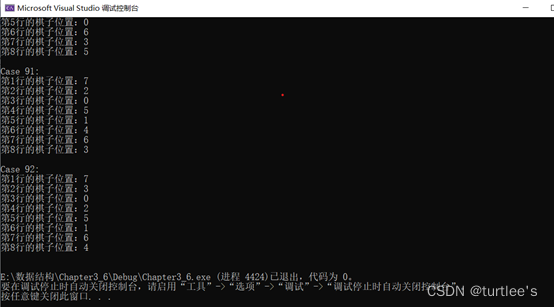
源代码:
#include <stdio.h>
#include <math.h>
int queenpos[8];//棋盘上有八个位置
int num = 1;
void Queen(int k);
int main()
{
Queen(0);//从0开始,棋子第一个点为(0,0)
return 0;
}
void Queen(int k) {
int i, j;
if (k == 8) {
//所有情况均已摆放,可以输出
printf("Case %d:\n", num++);
for (i = 0; i < 8; i++) {
printf("第%d行的棋子位置:%d\n", i + 1, queenpos[i]);
}
printf("\n");
}
else {
//摆放第k行
for (i = 0; i < 8; i++)
{
//确定列的数字
for (j = 0; j < k; j++) {
//对k行之前进行重复判断
if (queenpos[j] == i || abs(queenpos[j] - i) == (k - j) ){
break;
}
}
if (j == k) {
queenpos[k]=i;
Queen(k+1);
}
}
}
}
【第3.7题解答】
解题思路:
若当前位置“可通”,则纳入路径,继续前进;若当前位置“不可通”,则后退,换方向继续探索;四周“均无通路”,则将当前位置从路径中删除出去。
实验结果截图:
(1)迷宫无通路的情况
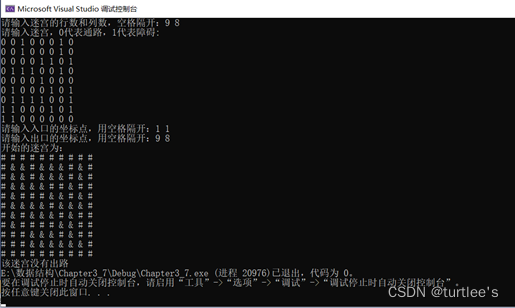
(2)迷宫有通路的情况
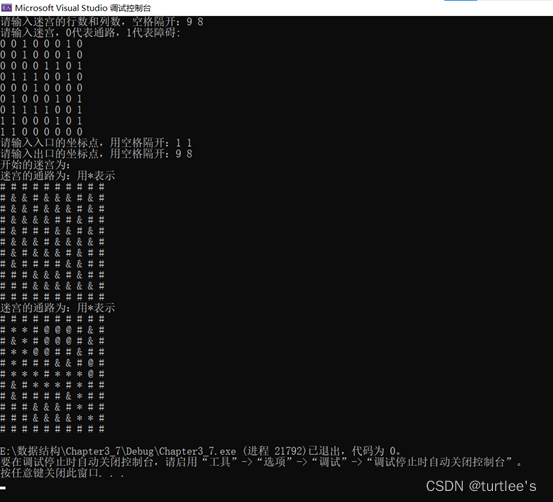
源代码:
main.cpp
#include "Chapter3_7.h"
int main() {
MazeType maze;
int row, col,i,j;
printf("请输入迷宫的行数和列数,空格隔开:");
scanf_s("%d %d", &row, &col);
printf("请输入迷宫,0代表通路,1代表障碍:\n");
int b[100][100];
for (int i = 0; i < row; i++) {
for (j = 0; j < col; j++) {
scanf_s("%d", &b[i][j]);
}
}
InitMaze(&maze, b, row, col);
PosType Start, End;
printf("请输入入口的坐标点,用空格隔开:");
scanf_s("%d %d", &Start.x, &Start.y);
printf("请输入出口的坐标点,用空格隔开:");
scanf_s("%d %d", &End.x, &End.y);
printf("开始的迷宫为:\n");
PrintMaze(maze, row, col);
if (MazePath(&maze, Start, End)) {
PrintMaze(maze, row, col);
}
else {
printf("该迷宫没有出路");
}
return 0;
}
Chapter 3_7.h
#pragma once
#include <stdio.h>
#include <stdlib.h>
#define STACK_INIT_SIZE 100
#define STACKINCREMENT 10
#define _CRT_SECURE_NO_WARNINGS
#define OK 1
#define ERROR 0
#define OVERFLOW -2
#define TRUE 1
#define FALSE 0
typedef int Status;
typedef struct {
int x, y;//点的坐标
}PosType;
typedef struct {
PosType seat;//当前的坐标
int direction;//运动的方向
}SElemType;
typedef struct {
SElemType* base;
SElemType* top;
int stacksize;
}SqStack;
typedef struct {
char arr[11][10];
}MazeType;
Status InitStack(SqStack* S);//初始化一个栈来存放走过的路
Status Push(SqStack* S, SElemType e);//将走得通的方向压入栈
Status Pop(SqStack* S, SElemType* e);//走不通,删除该方向
Status StackEmpty(SqStack S);//判断栈是否为空
Status GetTop(SqStack S, SElemType* e);//获取栈顶元素
Status StackClear(SqStack* S);
//用户自定义初始化一个迷宫
Status InitMaze(MazeType* maze, int(*a)[100], int row, int col);
int MazePath(MazeType* maze, PosType start, PosType end);
int Pass(MazeType maze, PosType curpos);//如果该方向能通过,返回1
int Same(PosType pos1, PosType pos2);//
PosType NextPos(PosType curpos, int d);//判断下一个坐标
Status MarkPrint(MazeType* maze, PosType pos);//标记走过的路
Status FootPrint(MazeType* maze, PosType pos);
Status PrintMaze(MazeType maze, int row, int col);//打印输出
Chapter 3_7.cpp
#include "Chapter3_7.h"
Status InitStack(SqStack* S) {
S->base = (SElemType*)malloc(STACK_INIT_SIZE * sizeof(SElemType));
if (!S->base) {
exit(-1);
}
S->top = S->base;
S->stacksize = STACK_INIT_SIZE;
}
Status Push(SqStack* S, SElemType e) {
if (S->top - S->base >= S->stacksize) {
S->base = (SElemType*)realloc(S->base, (S->stacksize + STACKINCREMENT)
* sizeof(SElemType));
if (!S->base) {
exit(-1);
}
S->top = S->base + S->stacksize;
S->stacksize += STACKINCREMENT;
}
*S->top++ = e;
return OK;
}
Status Pop(SqStack* S, SElemType* e) {
if (S->top == S->base) exit(-1);
*e = *(--S->top);
return OK;
}
Status StackEmpty(SqStack S) {
if (S.top != S.base) return FALSE;
else return TRUE;
}
Status GetTop(SqStack S, SElemType* e) {
if (S.top == S.base) return FALSE;
*e = *(S.top - 1);
return OK;
}
Status StackClear(SqStack* S) {
S->top = S->base;
return OK;
}
//用户自定义输入一个迷宫
Status InitMaze(MazeType* maze, int(*a)[100], int row, int col) {
int i, j;
for (i = 0; i < (row + 2); i++) {//迷宫四周围上围墙
maze->arr[i][0] = '#';
maze->arr[i][row] = '#';
}
for (j = 0; j < (col + 1); j++) {
maze->arr[0][j] = '#';
maze->arr[10][j] = '#';
}
for (i = 1; i < (row + 1); i++) {
for (j = 1; j < (col + 1); j++) {
if (a[i - 1][j - 1] == 1) {//如果输入为1,标记为障碍
maze->arr[i][j] = '#';
}
else {
maze->arr[i][j] = '&';//如果输入为0,标记为通路
}
}
}
return OK;
}
int MazePath(MazeType* maze, PosType start, PosType end) {
SqStack S;
InitStack(&S);
SElemType e ;
PosType curpos = start;
int curstep = 1;
int found = FALSE;
do {
if (Pass(*maze, curpos)) {
//返回值为1,当前位置可以走通
e = { curpos,1 };
Push(&S, e);
FootPrint(maze, curpos);
if (Same(curpos, end)) found = TRUE;//出口
else {
//下一个点
curpos = NextPos(curpos, 1);
}
curstep++;
}
else {
//当前位置不通过
if (!StackEmpty(S)) {
Pop(&S, &e);//退出当前失败的结点
while ((e.direction == 4) && !StackEmpty(S)) {
//回溯到过去不能用的点
MarkPrint(maze, e.seat);//标记退格的结点
Pop(&S, &e);
curstep--;
}
}
if (e.direction < 4) {
e.direction++;
Push(&S, e);//试试没有走完方向的点
curpos = NextPos(e.seat, e.direction);
}
}
}while (!StackEmpty(S) && !found);
return found;
}
int Pass(MazeType maze, PosType curpos) {
//检测当前位置能否走通
if (maze.arr[curpos.x][curpos.y] != '#' &&
maze.arr[curpos.x][curpos.y] != '*' &&
maze.arr[curpos.x][curpos.y] != '@') {
return 1;
}
else
return 0;
}
int Same(PosType pos1, PosType pos2) {
//检测两个点是否一致
if (pos1.x == pos2.x && pos1.y == pos2.y) {
return 1;
}
else
return 0;
}
PosType NextPos(PosType curpos, int d) {
//给出当前位置和方向,输出下一个点的坐标
PosType k = { 0,0 };
if (d == 1) {
k.x = curpos.x;
k.y = curpos.y+1;//向东走
}
else if (d == 2) {
k.x = curpos.x + 1;//向南走
k.y = curpos.y;
}
else if (d == 3) {
k.x = curpos.x;
k.y = curpos.y - 1;//向西走
}
else if (d == 4) {
k.x = curpos.x - 1;//向北走
k.y = curpos.y;
}
return k;
}
Status MarkPrint(MazeType* maze, PosType pos) {
//对走不通的路进行标记
maze->arr[pos.x][pos.y] = '@';
return OK;
}
Status FootPrint(MazeType* maze, PosType pos) {
//对通路进行标记
maze->arr[pos.x][pos.y] = '*';
return OK;
}
Status PrintMaze(MazeType maze, int row, int col) {
//打印任意规模大小的迷宫
printf("迷宫的通路为:用*表示\n");
int i, j;
for (i = 0; i < (row + 2); i++) {
for (j = 0; j < (col + 2); j++) {
printf("%c ", maze.arr[i][j]);
}
printf("\n");
}
return OK;
}
























 被折叠的 条评论
为什么被折叠?
被折叠的 条评论
为什么被折叠?








